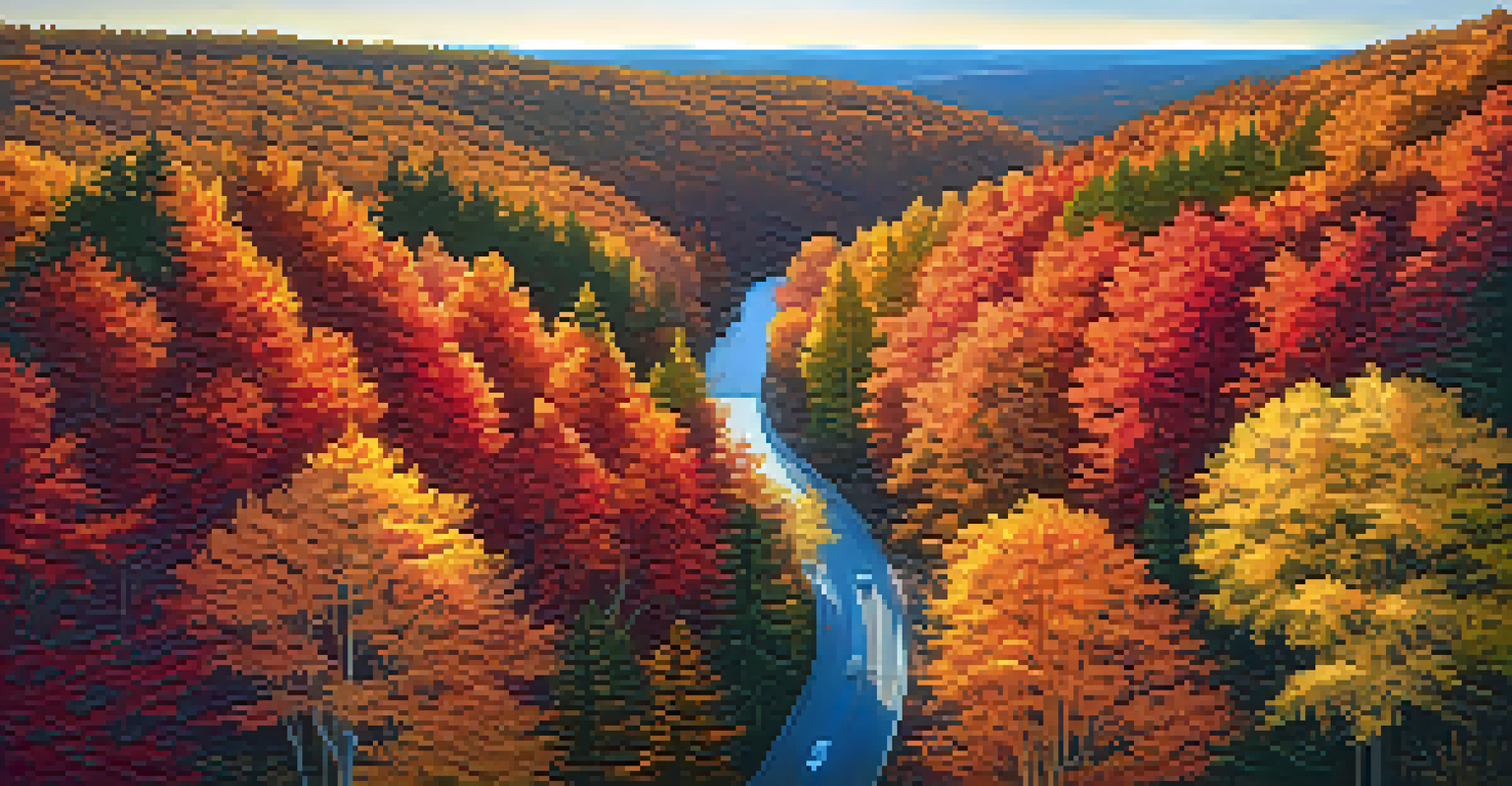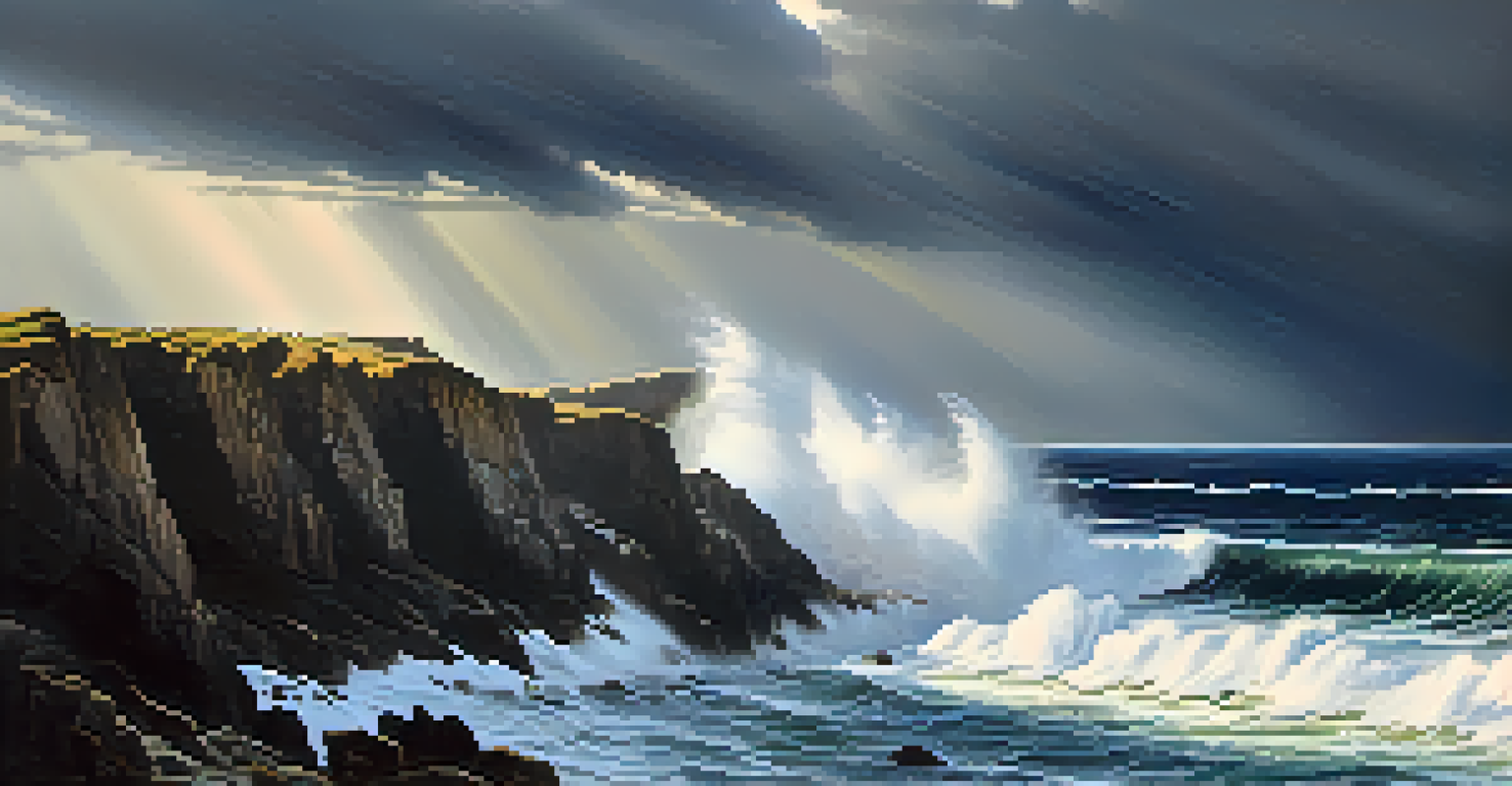The Role of Nature in the Development of Landscape Art

Nature's Beauty as Inspiration for Artists
Throughout history, the breathtaking beauty of nature has served as a muse for countless artists. From the rolling hills of the English countryside to the dramatic cliffs of the Pacific coast, the diverse elements of the natural world inspire creativity and evoke emotion. Artists often seek to capture not just the visual aspects of nature, but its essence and spirit, which can resonate deeply with viewers.
Art is the most beautiful of all lies.
For instance, the Impressionists of the late 19th century, like Claude Monet, painted en plein air, directly engaging with their surroundings. This method allowed them to portray the shifting light and colors of landscapes in ways that felt immediate and alive. By immersing themselves in nature, they created works that reflected the changing moods of their subjects, bringing landscapes to life in a new and vibrant manner.
Moreover, nature's ever-changing dynamics, from seasons to weather patterns, offer artists a continuous source of inspiration. Each artwork can serve as a snapshot of a specific moment in time, highlighting the fleeting beauty of a sunset or the stillness of a misty morning. This relationship between nature and art is a testament to how deeply intertwined they are, with one continually influencing the other.
Cultural Perspectives on Landscape Art
Different cultures have interpreted landscape art in unique ways, often reflecting their relationship with the environment. In traditional Chinese paintings, for example, landscapes are not just depictions of nature but carry philosophical meanings and cultural narratives. Mountains and rivers symbolize strength and endurance, and artists use these elements to convey deeper spiritual messages.

Conversely, Western landscape art has evolved to focus more on individualism and realism, particularly during the Romantic era. Artists like Caspar David Friedrich infused their landscapes with personal emotion and grandeur, encouraging viewers to reflect on their place within nature. This exploration of self in relation to the vastness of the natural world signifies a cultural shift in how landscapes were perceived.
Nature Inspires Artistic Expression
The beauty of nature has historically served as a profound muse for artists, influencing their creative endeavors and emotional expressions.
As globalization expands, the dialogue between different cultural perspectives on landscape art continues to enrich the genre. Contemporary artists often blend these influences, creating works that challenge traditional boundaries and invite viewers to appreciate nature from multiple viewpoints. This interplay not only expands the definition of landscape art but also fosters a greater understanding of how culture shapes our perception of the natural world.
The Evolution of Landscape Painting Techniques
Over the centuries, the techniques used in landscape painting have transformed dramatically, influenced by advancements in materials and artistic philosophies. Early landscape artists often relied on traditional methods, such as oil on canvas, to achieve depth and detail. However, with the introduction of watercolor and acrylics, artists gained new ways to express the fluidity of nature and its colors.
Nature is not a place to visit. It is home.
The Impressionist movement marked a significant turning point, as artists began to experiment with quick brush strokes and vibrant palettes to capture the essence of a scene rather than its precise details. This shift allowed for a more spontaneous representation of landscapes, reflecting the way light interacts with different elements in the environment. Techniques like color mixing directly on the canvas created a sense of immediacy in their works.
In modern times, digital art has emerged as a new frontier for landscape artists, enabling them to manipulate images and explore landscapes in ways previously unimaginable. Digital tools allow for experimentation with textures, lighting, and colors, broadening the possibilities of representation. This evolution of techniques demonstrates how artists continually adapt to both technological advancements and the ever-changing landscapes around them.
The Role of Nature in Artistic Movements
Nature has played a pivotal role in various artistic movements, serving as both inspiration and subject matter. The Hudson River School, for example, was a group of American painters in the 19th century who celebrated the beauty of the American wilderness. They emphasized the grandeur of nature, reflecting the burgeoning national identity and the desire to connect with the untamed landscapes of the continent.
Similarly, the Symbolist movement used nature as a metaphor for emotional and spiritual themes. Artists like Vincent van Gogh infused their landscapes with personal symbolism, often reflecting their internal struggles and emotions. The swirling skies and vibrant colors in his works convey a deep connection to nature, suggesting that our emotional states are often mirrored in the environment around us.
Cultural Views Shape Landscape Art
Different cultures interpret landscape art uniquely, reflecting their relationships with nature and fostering a rich dialogue among artistic traditions.
In contemporary art, nature continues to influence movements focused on environmentalism and sustainability. Artists are increasingly using their platforms to raise awareness about ecological issues, often incorporating natural materials or themes into their work. This alignment of art with environmental advocacy emphasizes the ongoing dialogue between nature and human creativity, urging society to consider the impact of our actions on the planet.
Nature's Role in Landscape Art and Environmental Awareness
As climate change and environmental degradation become pressing global concerns, the role of nature in landscape art has taken on a new significance. Artists are now using their work as a form of activism, highlighting the beauty of natural landscapes while also calling attention to their fragility. This dual purpose not only celebrates nature but also serves as a reminder of the urgent need for conservation.
For example, contemporary artists like Olafur Eliasson create immersive installations that encourage viewers to engage with the environment. His works often use natural elements like light and water to foster a deeper connection to the world around us. By making nature an integral part of the artistic experience, he highlights its importance in our lives and the need for its preservation.
Additionally, exhibitions focused on environmental themes are becoming more common, providing platforms for artists to address ecological issues. These initiatives not only raise awareness but also inspire viewers to reflect on their relationship with nature. As landscape art evolves in response to contemporary challenges, it continues to play a vital role in fostering a greater appreciation for the environment.
The Influence of Technology on Landscape Art
In today's digital age, technology significantly influences how landscape art is created and perceived. From photography to digital painting, artists have access to an array of tools that allow them to explore landscapes in innovative ways. This technological advancement not only enhances creativity but also expands the reach of landscape art to a broader audience.
For instance, drone photography has revolutionized landscape art by providing unique aerial perspectives that were previously unattainable. Artists can now capture sweeping vistas and intricate details from heights that offer new insights into familiar landscapes. This fresh viewpoint encourages viewers to see the world from different angles, deepening their appreciation for nature's complexity.
Technology Transforms Art Creation
Advancements in technology, such as digital tools and drone photography, are revolutionizing landscape art, allowing for innovative exploration and broader audience engagement.
Moreover, social media platforms facilitate the sharing of landscape art, allowing artists to connect with global audiences. This exchange fosters community engagement and inspires collaboration among artists from diverse backgrounds. Through technology, landscape art transcends geographical boundaries, creating a shared appreciation for the beauty of nature across cultures.
Future Directions in Landscape Art
As we look to the future, the relationship between nature and landscape art is bound to evolve further. Artists will continue to explore new mediums and technologies, pushing the boundaries of traditional landscape painting. This ongoing experimentation will likely result in fresh interpretations of nature that challenge conventional perspectives and encourage viewers to see landscapes in new ways.
Additionally, the growing awareness of environmental issues will likely inspire more artists to integrate themes of sustainability and conservation into their work. By highlighting the beauty and fragility of natural landscapes, artists can provoke thought and inspire action, encouraging audiences to take responsibility for the planet's well-being. This shift toward environmental consciousness in art signifies a powerful movement that aligns creativity with advocacy.

Ultimately, the role of nature in landscape art will remain a dynamic interplay of inspiration and reflection. As artists continue to engage with the natural world, they will not only document its beauty but also confront the challenges it faces. This ongoing dialogue between art and nature promises to enrich our understanding of both, inviting us to appreciate and protect the landscapes that shape our experiences and identities.